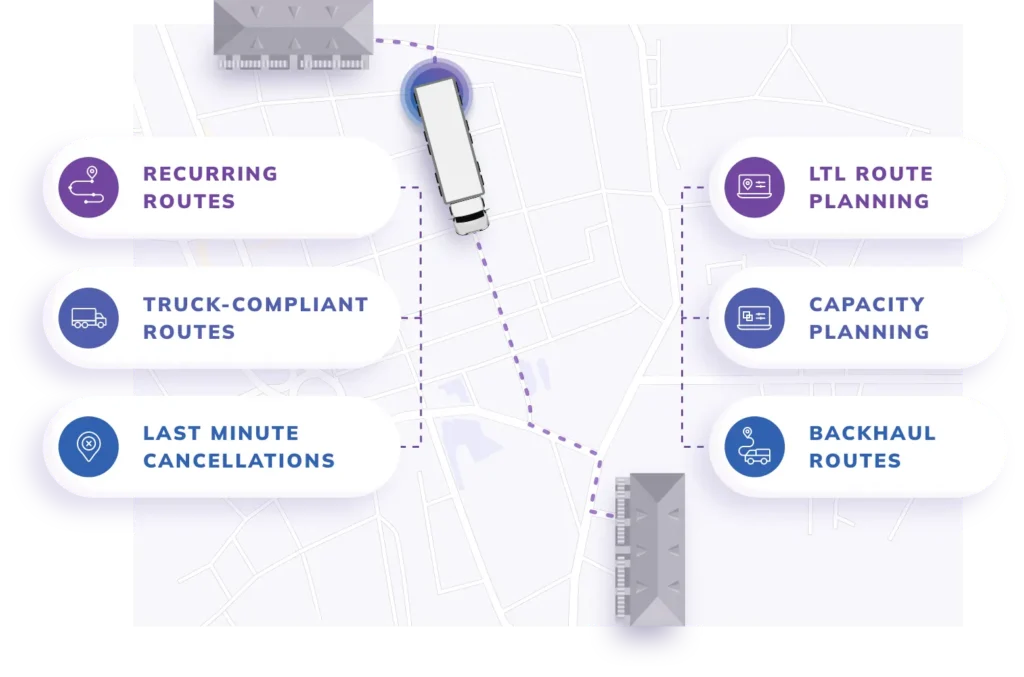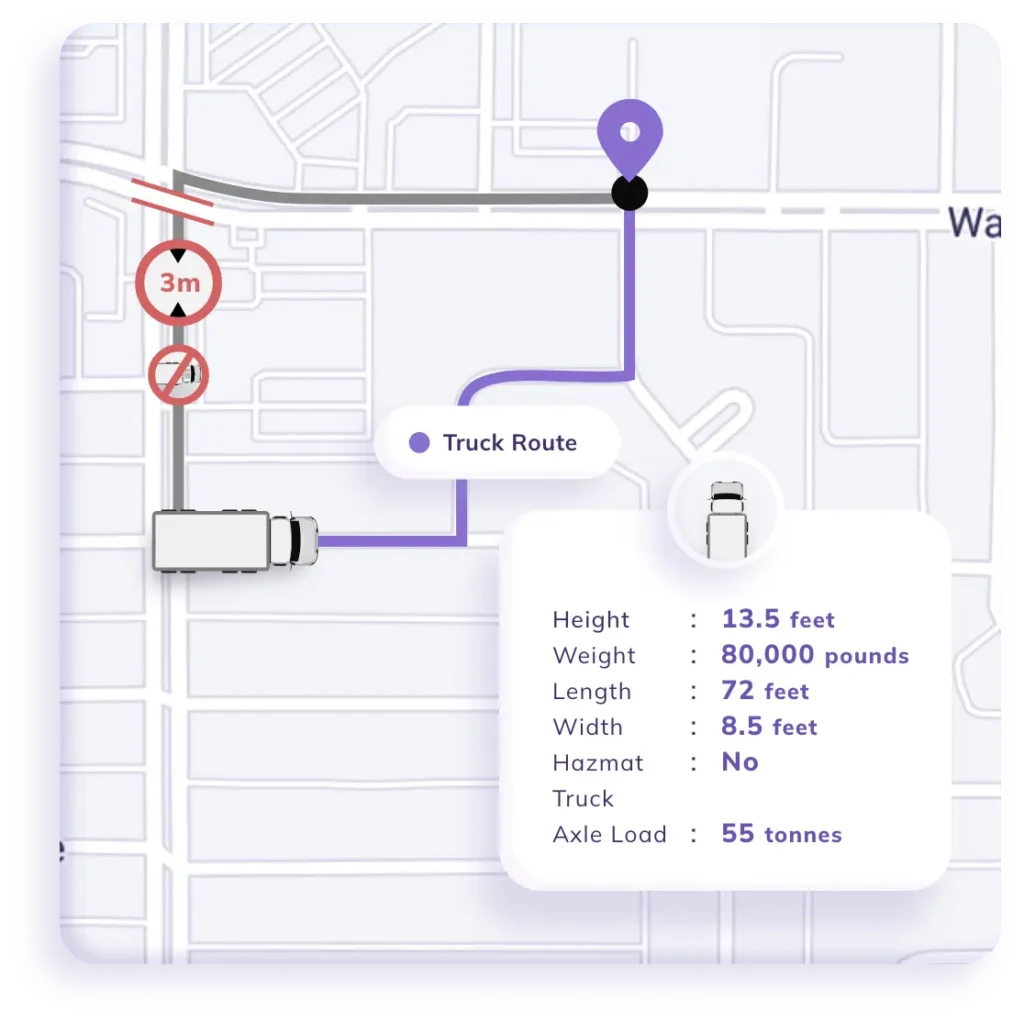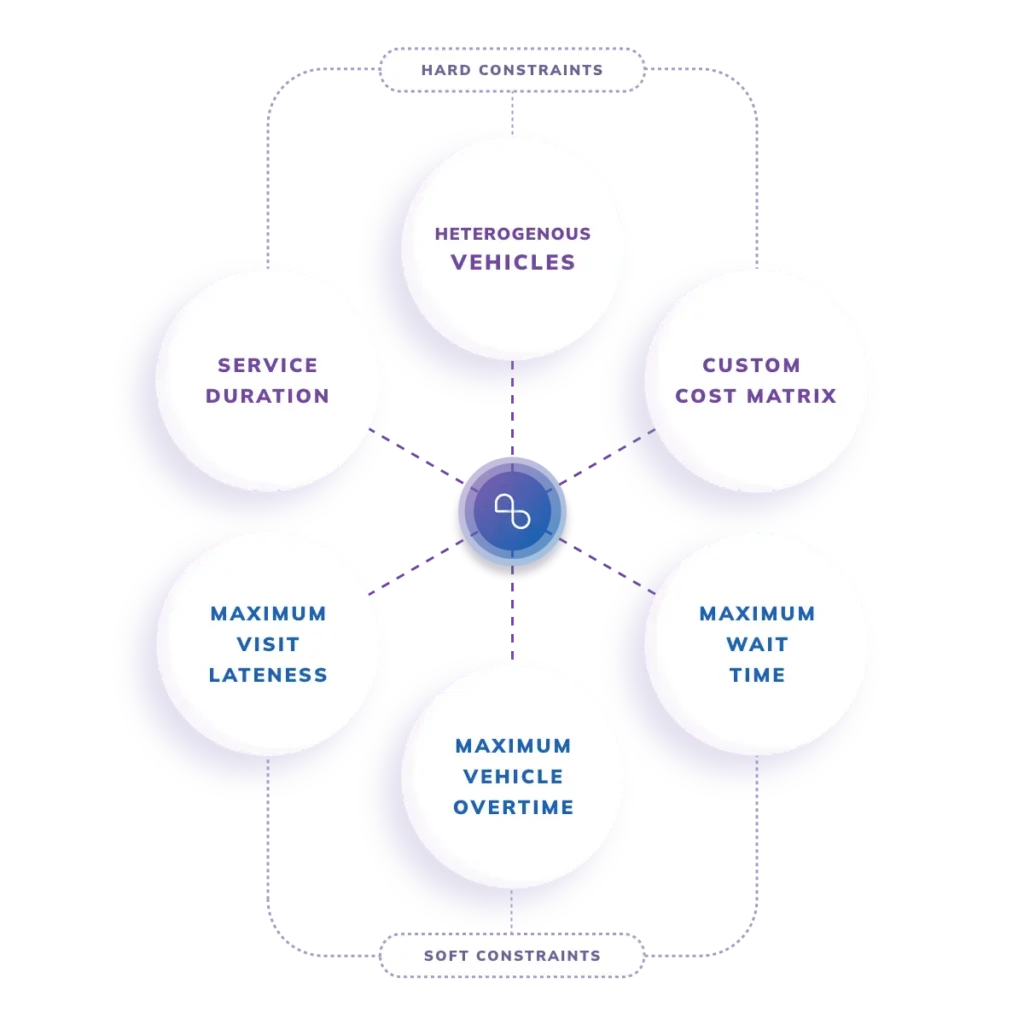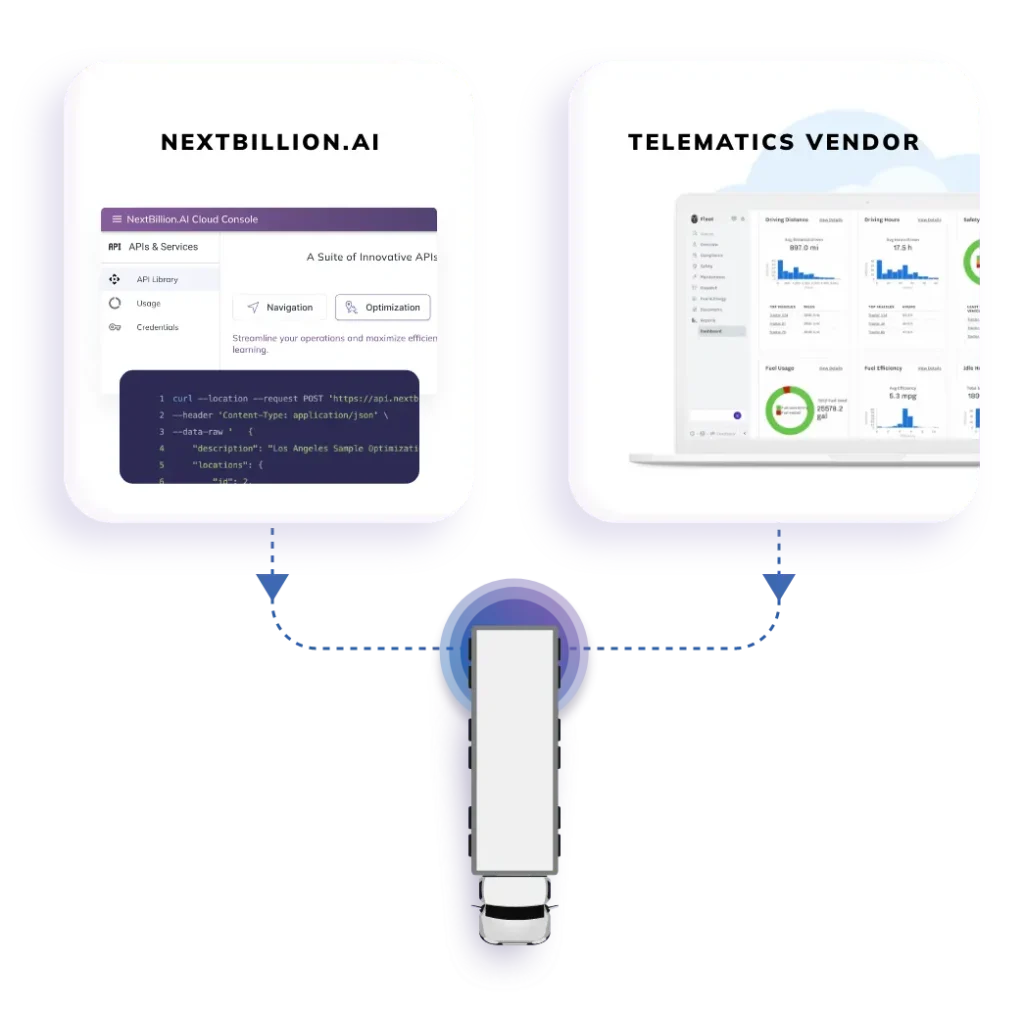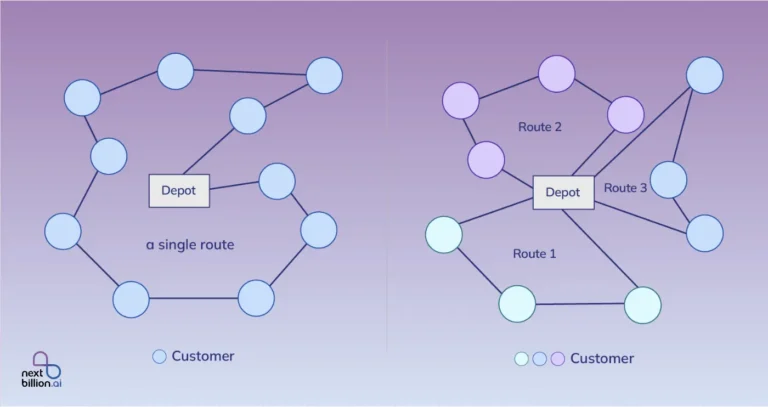
Table of Contents
Middle-mile delivery is the backbone of B2B logistics, connecting suppliers, distribution centers, and retailers. Optimizing this segment is crucial—it directly impacts costs, delivery times, and overall supply chain efficiency.
In this comparison, I’ll break down how NextBillion.ai and Google Route Optimization API tackle middle-mile logistics. You’ll see how each platform handles route planning, optimization, and integrations, helping you choose the right solution for your business.
NextBillion.ai VS Google Middle Mile Delivery Features
When it comes to middle-mile delivery, choosing the right route optimization solution can make all the difference in efficiency, cost savings, and operational flexibility. In this section, we’ll compare the top features of NextBillion.ai and Google’s Route Optimization API to help you understand how they stack up. First, let’s dive into NextBillion.ai’s key capabilities.
NextBillion.ai Features
The following features stand out for NextBillion.ai’s Route Optimization API.
Handling 50+ Constraints for Complex Route Planning
NextBillion.ai supports over 50 different constraints to optimize middle-mile deliveries. These include vehicle capacities, delivery time windows, real-time traffic conditions, and driver shift limits. Businesses can create highly customized routes that fit their specific operational needs, reducing inefficiencies and enhancing delivery precision.
How It’s Used:
- Define constraints such as vehicle type, load capacity, and time restrictions.
- Generate optimized routes that minimize costs and improve delivery efficiency.
- Adjust plans dynamically as conditions change.
Why It’s Important: By accounting for multiple constraints simultaneously, NextBillion.ai helps businesses handle complex route planning challenges, ensuring smooth and cost-effective operations.
Support for Repetitive and Recurring Routes
For businesses with scheduled deliveries, NextBillion.ai offers built-in support for repetitive and recurring routes. This feature ensures consistency, reduces route planning time, and optimizes delivery patterns.
How It’s Used:
- Set up predefined schedules for daily, weekly, or monthly deliveries.
- Optimize recurring routes based on historical data and real-time updates.
- Ensure drivers follow the most efficient paths for repeated stops.
Why It’s Important: Automating recurring deliveries ensures efficiency, reduces manual intervention, and improves reliability in middle-mile operations.
Preplanning and Real-time Reoptimization
NextBillion.ai enables businesses to preplan routes while offering real-time reoptimization. This means companies can plan routes in advance based on historical data while also dynamically adjusting to real-world disruptions such as traffic congestion or sudden order changes.
How It’s Used:
- Create optimized delivery routes before dispatch.
- Adjust routes in real time based on traffic, delays, or new orders.
- Integrate dynamic rerouting with existing fleet management systems.
Why It’s Important: Preplanning ensures efficiency, while real-time reoptimization allows businesses to stay agile, adapting to unforeseen challenges with minimal disruption.
Advanced Routing Features for B2B Deliveries
Middle-mile deliveries often involve complex logistics, such as handling multi-compartment trucks, cold chain logistics, and diverse product types. NextBillion.ai’s advanced routing capabilities address these challenges.
How It’s Used:
- Assign multi-compartment trucks for temperature-sensitive deliveries.
- Optimize routes based on cargo type, weight, and capacity.
- Minimize empty miles and improve fleet efficiency with backhaul routes.
Why It’s Important: Businesses can reduce fuel costs, improve delivery timelines, and maintain product integrity, especially for specialized logistics like pharmaceuticals and food distribution.
Scenario Planning and Simulation
NextBillion.ai allows businesses to test various routing strategies under different scenarios, helping them anticipate and mitigate potential disruptions.
How It’s Used:
- Simulate different demand scenarios and routing strategies.
- Identify potential risks and optimize resource allocation.
- Adjust routing parameters based on predictive analysis.
Why It’s Important: With scenario planning, businesses can proactively manage uncertainties and ensure smooth operations even in challenging conditions.
NextBillion.ai is the Right Choice If:
✅ You need highly customized route planning with support for 50+ constraints.
✅ Your business requires recurring route optimization for scheduled deliveries.
✅ You want advanced routing for specialized logistics like cold chain and multi-compartment trucking.
NextBillion.ai Isn’t the Best Option If:
❌ You’re looking for a simple, plug-and-play solution without complex customization needs.
❌ Your operations do not require real-time reoptimization or constraint-based routing.
❌ You prefer an off-the-shelf solution with minimal setup requirements.
Google Features
Google’s Route Optimization API offers a range of features designed to improve fleet efficiency, optimize route planning, and manage vehicle assignments based on specific business objectives.
1. Dynamic Route Optimization
Google’s API enables businesses to dynamically optimize routes based on real-time traffic conditions, distance, and time-to-destination. The system helps fleets reduce travel time and fuel consumption by continuously recalculating routes as conditions change. This feature is particularly strong in urban environments where Google’s traffic data is highly accurate.
Comparison: While Google excels in real-time traffic analysis, NextBillion.ai offers deeper customization for businesses needing more control over parameters like vehicle capacity, service time, and multi-stop optimization.
2. Task and Fleet Assignment
Google’s fleet optimization assigns tasks based on vehicle capacity, driver work hours, and dependencies between deliveries. The system ensures that tasks are distributed efficiently, reducing the number of vehicles needed and balancing workloads among drivers.
Comparison: Google’s task assignment is effective for standard constraints, but NextBillion.ai handles more complex fleet scenarios, such as multi-compartment truck routing and cold chain logistics, making it better suited for specialized industries.
3. Time Window Management
With Google’s time window constraints, businesses can ensure that deliveries and pickups happen within designated time slots. The API takes into account factors like expected traffic and estimated service duration, helping improve on-time arrivals.
Comparison: Google’s time window management works well for basic scheduling, but NextBillion.ai’s system allows for greater flexibility, such as dynamic re-optimization based on live changes and the ability to factor in multiple constraints simultaneously.
Google is the right choice if:
✅ You need fast and easy access to Google’s real-time traffic data
✅ Your business operates primarily in urban areas with standard delivery constraints
✅ You require a simple, out-of-the-box solution with minimal customization
Google isn’t the best option if:
❌ You need advanced constraint handling for complex route planning (e.g., multi-compartment trucks, cold chain logistics)
❌ Your business requires repetitive and recurring route planning with dynamic re-optimization
❌ You need deep customization beyond Google’s predefined parameters
Google VS NextBillion.ai Integrations
Seamless integrations with existing logistics and fleet management systems are critical for maximizing efficiency in route planning and delivery operations. Both NextBillion.ai and Google provide integration capabilities, but they differ in flexibility, customization, and cross-platform compatibility. Let’s explore how each platform handles integrations.
NextBillion.ai Integrations
NextBillion.ai offers a wide range of seamless integrations with leading Transportation Management Systems (TMS), telematics solutions, and fleet management platforms. These integrations ensure smooth data exchange and enable businesses to optimize their operations with real-time insights.
- Effortless Connectivity: NextBillion.ai easily integrates with major TMS and telematics providers, allowing logistics companies to streamline their workflows without major technical roadblocks.
- Real-Time Data Sync: Businesses gain access to real-time vehicle locations, shipment updates, and performance metrics, ensuring accurate and up-to-date decision-making.
- Customizable Solutions: Unlike rigid APIs, NextBillion.ai’s integration capabilities are highly customizable, allowing businesses to adapt integrations to their unique operational needs.
NextBillion.ai connects with fleet tracking systems, order management platforms, and ERP software, helping logistics companies create a fully automated routing and dispatching workflow.
Google Integrations
Google’s Route Optimization API provides integration capabilities within its ecosystem, primarily working with Google Maps, Google Cloud, and Google’s suite of services.
- Google Ecosystem Lock-In: Google’s API is designed to function best within its own ecosystem, which can restrict businesses that rely on third-party TMS, CRM, or ERP systems.
- Limited API Flexibility: While Google’s API is highly optimized for traffic and routing, customizing integrations for specific logistics workflows often requires additional development effort or middleware solutions.
- Compatibility Issues with TMS and Telematics: Many logistics companies use a mix of software solutions for fleet tracking, order management, and dispatching. However, Google’s API may require additional work to ensure compatibility with non-Google platforms, leading to integration bottlenecks.
Google’s Route Optimization API is mainly designed to enhance Google Maps functionality but lacks native integrations with leading TMS and telematics platforms used in logistics operations.
Wrap Up
If you need a highly customizable and flexible integration solution with leading logistics platforms, NextBillion.ai is the better choice.
If you primarily operate within Google’s ecosystem and don’t require cross-platform integration, Google’s Route Optimization API might be sufficient.
Google VS NextBillion.ai Pricing
Pricing is a critical factor when choosing a route optimization solution, and both NextBillion.ai and Google offer distinct pricing models. NextBillion.ai follows a value-based pricing approach, ensuring businesses only pay for the value they receive rather than just the number of API calls. On the other hand, Google’s pricing is API-call-based, which can lead to escalating costs for businesses with high routing demands.
NextBillion.ai Pricing
NextBillion.ai offers three flexible pricing plans tailored to different levels of logistics complexity. Whether you run a small delivery operation or a large-scale cross-border fleet, there’s a plan that fits your needs.
Features | Basic (Low Complexity) | Advanced (Most Popular) | Bespoke (Enterprise) |
Route Optimization API | Basic route optimization | Advanced route optimization | Advanced route optimization (customized) |
Basic distance matrix | Advanced distance matrix | Advanced distance matrix (customized) | |
Vehicle Profiles | Car routing | Truck routing | Any vehicle routing |
Traffic Data | Traffic-aware ETAs | Traffic-aware ETAs | AI-powered ETAs with custom models |
Map Customizations | Standard maps | Standard maps | Custom maps & private road edits |
Deployment Options | Multi-tenant cloud | Multi-tenant cloud | On-premises or custom deployment |
Integrations | All standard integrations | All standard integrations | Custom integrations |
Support | Basic support | Solution support | White-glove enterprise support |
Key Advantages of NextBillion.ai’s Pricing
✅ Pay for the value, not API calls – Unlike Google, NextBillion.ai doesn’t charge based on the number of requests but rather on business value and complexity.
✅ Flexible Deployment Options – Businesses can choose between cloud-based, hybrid, or on-premise solutions for better control over costs and security.
✅ Custom Integrations & AI-Driven Features – The Bespoke plan allows for custom routing solutions tailored to unique operational needs.
Google Route Optimization API Pricing
Google’s pricing model is based on API call usage, which means the more requests a business makes, the higher the cost. This can become expensive for large-scale logistics operations.
Category | SKU Name | Free Usage Cap | 100,001 – 500,000 Requests | 500,001 – 1,000,000 Requests | 1,000,001 – 5,000,000 Requests | 5,000,000+ Requests |
Pro Plan | Single Vehicle Routing | 5,000 | $10.00 per 1,000 requests | $4.00 per 1,000 requests | $2.00 per 1,000 requests | $0.80 per 1,000 requests |
Enterprise Plan | Fleet Routing | 1,000 | $30.00 per 1,000 requests | $14.00 per 1,000 requests | $6.00 per 1,000 requests | $2.40 per 1,000 requests |
Wrapping Up
Choosing between NextBillion.ai and Google Route Optimization API for middle-mile delivery depends on your logistics complexity, customization needs, and budget.
If your business requires advanced route optimization for B2B deliveries, order grouping, backhaul optimization, and LTL (Less-than-Truckload) planning, NextBillion.ai is the better choice. It can handle multi-vehicle routing, real-time reoptimization, and over 50 constraints like vehicle capacity, time windows, and load compatibility—ensuring efficient and cost-effective middle-mile operations. Additionally, its seamless integration with TMS and telematics enhances visibility and operational control.
On the other hand, Google’s Route Optimization API is more suitable for businesses that operate within the Google ecosystem and require basic fleet routing without deep customization. However, limited third-party integrations and a pay-per-API-call pricing model can make it costly and less adaptable for large-scale middle-mile logistics.
Which One Should You Choose?
- If you need customized middle-mile route optimization, cost-effective pricing, and seamless integrations with your existing systems, NextBillion.ai is the right solution.
- If your middle-mile operations are simple, Google-based, and don’t require deep customization, Google’s Route Optimization API may work—but be mindful of potential limitations in flexibility and costs.
For businesses that rely on efficient, scalable, and intelligent middle-mile delivery planning, NextBillion.ai delivers a robust and adaptable solution.
Want to see how NextBillion.ai can optimize your middle-mile logistics? Request a demo today!
About Author
Shivangi Singh
Shivangi is a seasoned Technical Writer with a passion for simplifying technical concepts. With over 5 years of experience, she specializes in crafting clear and concise documentation for various technical products and platforms.






